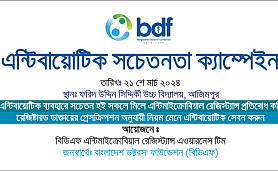Nutritional deficiency constitutes a major public health problem worldwide and often associated with fatal outcome. The malnutrition scenario presented by UNICEF in 2011 showed that 52 million children under 5 years of age were moderately or severely wasted, more than 29 million under 5, an estimated 5 percent suffered from severe wasting, Bangladesh has a very high prevalence of malnutrition-above 15 percent.
However, a recent hospital-based systematic surveillance study in a diarrhoea treatment centre in Dhaka, Bangladesh revealed that severe wasting, severe stunting and severe under-nutrition in under 5 children were 3%, 11% and 16% respectively [3]. Every year over 4 million children are born in Bangladesh and nearly 289,000 of them die before reaching their fifth birthday.
To determine the role of four clinical signs (bradycardia, low volume pulse, impaired consciousness and delayed capillary refilling time) in predicting the death of severely malnourished children admitted in the hospital.
All the cases of severe acute malnutrition in age group of 3 months to 59 months were included during the study period of March 2016 to September 2016. History, physical findings and particularly four clinical signs- bradycardia, low volume pulse, impaired consciousness and capillary refill time > 3 sec were recorded for all the children.
They were treated as per WHO guideline with prevention and treatment of hypoglycaemia, hypothermia, dehydration, electrolyte imbalance, treatment of infections and other problems including shock and severe anaemia. Feeding was started with F-75 formula for one week, then replaced by F-100. They were also given multivitamin, folic acid and zinc. Outcome particularly death of the patients was recorded, co-morbidities, duration of their hospital stay were also recorded. Children who had any one or more of the four clinical signs were then considered as case and rest as control. The death as outcome was then compared in the two groups to see whether the four clinical signs predicting the outcome.
A total of 116 children with age range of 3 months to 59 months were included. Male: female ratio was 1.42:1. Among them 59 children(case) had one or more of the 4 clinical signs- bradycardia, weak low volume pulse, impaired consciousness and capillary refilling time >3sec and 57 children(control) had no such signs. The odds ratio for death was 11.53 (95% CI= 3.21 – 41.37) for children who had one or more of the 4 clinical signs. Of the secondary outcome odds ratio of hypoglycaemia, lethargy, dehydration, shock, hypothermia and convulsion were 2.86, 91.86, 7.36, 97.3, 4.35 and 4.57 respectively. Odds ratio of hyponatraemia, hypokalaemia, severe anaemia, severe acidosis and elevated serum creatinine were 5.6, 1.96, 4.07, 5 and 4.2 respectively. Odds ratio of hypoglycaemia, hypothermia, lethargy, dehydration and shock were statistically significant and among laboratory findings only hyponatraemia was statistically significant. The odds ratio of convulsion, hypokalaemia, severe anaemia, severe acidosis and elevated serum creatinine were not statistically significant.
The study identified four clinical features (impaired consciousness, low volume pulse, capillary refilling time (CRT) > 3 sec and bradycardia) that could define a high-risk group to target aggressive treatment. However, large-scale multicentre study will be needed to validate the findings of the present study.
Dr. Farhana Akhter Faruque
Junior Consultant (Pediatrics), MCPS (Pediatrics), FCPS (Pediatrics),
250 Bedded General Hospitals, Naogaon, Bangladesh
Dr. Md. Ataur Rahman
Associate Professor, FCPS (Pediatrics),
Department of Pediatrics, Shaheed Ziaur Rahman Medical College, Bogura, Bangladesh
Dr. Md. Nurul Absar
Medical Officer, DCH, FCPS (Pediatrics)
250 Bedded Sadar Hospitals, Feni, Bangladesh
Dr. Joyashree Chakraborty,
Junior Consultant (Pediatrics), FCPS (Pediatrics)
250 Bedded General Hospitals, Gopalganj, Bangladesh
For more about this, please follow the link https://saspublishers.com/media/articles/SJAMS_83_989-995_ZLhMxI0.pdf





